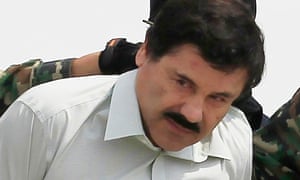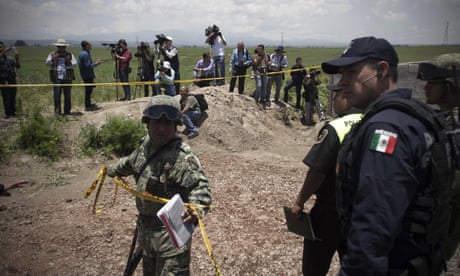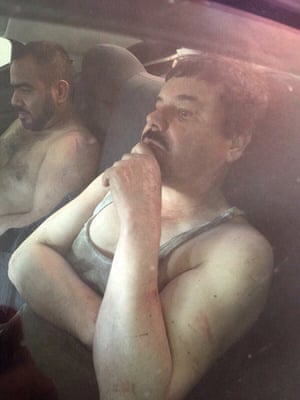El Chapo recaptured: Mexican president announces 'mission accomplished'
President tweets ‘We’ve got him’ six months after notorious drug cartel leader Joaquín Guzmán made elaborate escape from maximum-security prison

Joaquín ‘El Chapo’ Guzmán is escorted by soldiers after a previous capture in February 2014. Photograph: Henry Romero/Reuters
Mexico’s president has announced the recapture of cartel kingpin Joaquín “El Chapo” Guzmán, whose escape in July from a maximum-security prison – the second in less than 15 years – humiliated the country’s federal government and exposed corruption in the country’s prison system.
President Enrique Peña Nieto made the announcement on Twitter, saying: “Mission accomplished: we’ve got him. I would like to inform the Mexican people that Joaquín Guzmán Loera has been captured.”
— Enrique Peña Nieto (@EPN)January 8, 2016
Misión cumplida: lo tenemos. Quiero informar a los mexicanos que Joaquín Guzmán Loera ha sido detenido.
The Mexican navy said in a statement that Guzmán, the head of the powerful Sinaloa cartel, was captured after a shootout with marines in the early morning hours in the city of Los Mochis, in Guzmán’s home state.
Five people were killed in the shootout, though only one marine was injured, while weapons, a rocket launcher and bulletproof vehicles were captured.
The capture marks the second time Guzmán has been apprehended in the last three years. Mexican marines captured him in Mazatlán in early 2013 after a series of narrow escapes.
But in July last year, he made a daring escape from Altiplano prison, 56 miles outside Mexico City, squeezing through a hole in his shower floor then fleeing through a mile-long tunnel on a modified motorbike mounted on a rail.

‘El Chapo’ affair: inside the prison from which Mexican drug lord escaped
At the time of his escape the capo wore a tracker bracelet and was under round-the-clock surveillance, but cameras inside his cell had two blind spots in the shower and toilet because of human rights requirements.
CCTV footage released in October showed that guards failed to intervene even thoughloud hammering was audible from Guzmán’s cell.
The grainy footage showed that Guzmán turned up the volume on a television by his bed to drown out the noise as his helpers hammered a hole through the floor under the shower.
The escape came less than three weeks after the United States filed a request to extradite Guzmán, and the kingpin’s lawyer told the Guardian last year that his escape wasprompted by fears that he would face trial in the US.
The Mexican government offered a reward of 60m pesos ($3.8m) for information leading to the drug lord’s recapture, but the escape was extremely embarrassing for Peña Nieto, who had previously said Guzmán’s escape would be “unforgivable”.

El Chapo after capture. Photograph: Office of the Mexican Attorney General
The president and federal officials were criticized for not extraditing Guzmán to the United States, despite shortcomings in the Mexican prison system.
It was the second time Guzmán had fled custody: in 2001 he escaped from another maximum-security prison, Puente Grande in western Jalisco state, reputedly hidden in a laundry cart.
Analysts say the capture gives the president a chance to regain some credibility after taking a political hit.
“If confirmed it’s obviously a great sign that in spite of concerns that Peña Nieto’s government would go easy on kingpins and organized crime, it hasn’t,” said Malcolm Beith, a journalist who wrote a biography of Guzmán.
“Catching Chapo again now gives Mexico a great opportunity to either try him quickly and fairly and make sure that if found guilty he remains behind bars – or extradite him and prove that US-Mexican relations are just as strong as ever.”
Hammering audible in El Chapo’s cell before prison escape
Analysts expect Guzmán to face extradition to the United States, especially after federal officials came under intense criticism for failing to do so the last time.
In 2014, the then attorney general Jesús Murillo Karam told the Associated Press that Guzmán would be extradited – but only after serving his sentence in Mexico, “Some 300 or 400 years later.”
“There’s a long ways to go,” he said at the time.
The US Drug Enforcement Administration was quick to congratulate the Mexican government on Friday, saying in a tweet that the agency was “extremely pleased at the capture”.
— DEA News (@DEANEWS)January 8, 2016
DEA is extremely pleased at the capture of Chapo Guzman. We congratulate the MX Government and salute the bravery involved in his capture
Over recent months Mexican forces had carried out a string of search operations in the Sierra Madre mountains of Sinaloa, and October Guzmán was reportedly injured before narrowly escaping.
Local people described aggressive raids in which villagers fled their homes to escape indiscriminate fire from helicopter gunships.
“There have been intense navy operations throughout the state for the past two months,” said Javier Valdés, publisher of the independent new site Ríodoce in Sinaloa’s capital city, Culiacán.
Valdés said that despite years in prison – and months on the run – Guzmán maintained a powerful influence in the region, adding that even after the arrest the Sinaloa cartel would be likely to carry on with its business as usual.
“It continued operating while he was in prison the last time,” he said.
Guzmán’s rags-to-riches story, and his previous success in evading capture have only added to his status in Sinaloa, a sliver of territory hugging the Pacific coastline with a lowland famed for its tomatoes, and remote mountain ranges renowned for their opium plantations and marijuana fields.
He achieved as sort of demigod status in the state, where his 2015 escape was greeted with celebratory gunfire and choruses ofnarcocorridos (songs lionizing narcos).
Guzmán was born in a remote and impoverished hamlet in the rugged Sierra Madre mountains. His father was a gomero, someone who picked opium poppies, while Guzmán sold oranges as a boy.
He rose to the top of the organized crime pyramid, despite being barely educated and expanded the Sinaloa cartel into a criminal organization with a global reach.

Post a Comment